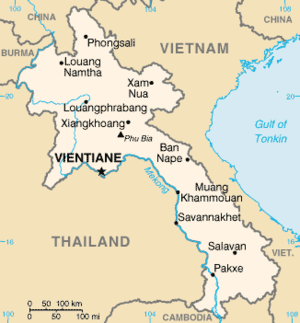
Back Опиумная война (1967) Russian 1967 අබිං යුද්ධය Singhalese Опіумна війна (1967) Ukrainian 1967年鴉片戰爭 Chinese
| 1967 Opium War | ||||||||
|---|---|---|---|---|---|---|---|---|
| Part of Laotian Civil War | ||||||||
 Fighting took place close to the border of Laos, Burma and China | ||||||||
| ||||||||
| Belligerents | ||||||||
|
|
|
| ||||||
| Commanders and leaders | ||||||||
| Warlord Khun Sa | Li Mi | Ouane Rattikone | ||||||
| Units involved | ||||||||
| Mule train |
|
| ||||||
| Strength | ||||||||
| 800 men | 700–1,000 men |
| ||||||
| Casualties and losses | ||||||||
| 82 KIA | 70 KIA | Unknown | ||||||
The 1967 Opium War took place in northwestern Laos between February and August 1967; actual fighting took place from 29 July to 1 August 1967. A mule train, led by Burmese militia, carrying 16 tons of opium crossed into Laos to Ban Khwan, where they were attacked by rival drug smugglers from the Chinese Nationalists' Third and Fifth Armies. The intended recipient of the shipment, Royal Lao Army General Ouane Rattikone, bombed both sides while moving in troops to sweep the battlefield. With both Burmese militia and Nationalist Chinese defeated and expelled from Laos, the Lao general confiscated the opium for himself.
With this supply of raw opium base, plus his greater grasp on the drug trade, Ouane's refineries began to ship their heroin worldwide. He also supplied this injectable heroin to his allies – U.S. troops in the Vietnam War.